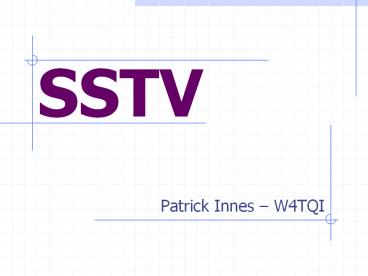SSTV - PowerPoint PPT Presentation
1 / 37
Title:
SSTV
Description:
Sample Pictures ... Pictures generated 'live' with flying ... Every time you transmit, you are representing amateur radio to the public! So Where's the SSTV? ... – PowerPoint PPT presentation
Number of Views:176
Avg rating:3.0/5.0
Title: SSTV
1
SSTV
- Patrick Innes W4TQI
2
What is SSTV?
- Slow Scan Television
- Method of sending still images by radio
3
SSTVs Many Modes
- SSTV is actually many different modes that all
do about the same thing - Scottie 1 / 2 / DX
- Martin 1 / 2
- Robot 24 / 36 / 72
- BW 8 / 12
- Digital SSTV not really related
4
Sample Pictures
- Quality of received picture depends on mode used,
signal strength, and band conditions
5
- What sorts of images are sent via SSTV?
6
Pictures of Hams
7
Their Gear
8
Their Families
9
Scenery
10
Where They Live
11
Cartoons
12
Space
13
Other Hobbies
14
Almost Anything!
15
Most Practical Application
- Emergency Services Damage Assessment
16
A Bit Of History
- Early SSTV hardware was scratchbuilt, using
long-presistence radar CRTs - Pictures generated live with flying-spot
scanners or vidicon tubes
17
Hardware-based SSTV
- Eventually, commercial hardware became available
- Specialized
- Expensive
- Only a few modes
- per unit
18
Recent Hardware
- 1990s Kenwood released the VC-H1
- Replaced mic on Kenwood radios
- Complete SSTV station in one
- compact unit
- Digital camera
- LCD screen
- Hand mic/speaker
- Supported several
- popular modes
19
Todays SSTV Hardware
- 100 MHz computer
- Windows 95 or later
- 32 MB of RAM
- 16-bit sound card
- Transceiver
- Some sort of interface
- (optional)
20
SSTV Software
- Several shareware and freeware packages available
- Most use sound cards DSP features to process the
audio signal - Most software allows operation of many different
modes
21
Available Software
- MMSSTV
- Freeware
- Most popular
- MixW
- Shareware (50)
- Many digital modes
- ChromaPix (120)
- Linux QSSTV
- Mac MultiMode
MMSSTV MixW
22
Possible SSTV Problems
- Slant
- Phase
- Tearing
- Doubling
- QRM
- D.O.M.S.
23
Slant
- Results in slanted or skewed image
- Caused by one or both stations being improperly
calibrated - Most software is easy to calibrate to WWV
- One properly calibrated computer can be used to
calibrate another if no time standard signal is
available - Software can compensate for some slant, but its
best to be calibrated
24
Slanted Pictures
25
Phase / Tearing
- Caused by a stall or interruption of the transfer
process - Often originates in the sending machine, but can
be caused on the receiving end - Most common causes
- Other programs running at the same time
- Not enough RAM or processor to handle the load
26
Torn Pictures
27
Doubling
Doubling
- Two or more stations transmitting at the same
time - SSTV is timing-critical, and two signals will
never be exactly in sync with each other - Result depends on relative signal strengths
- From starting over with the stronger signal to
unreadable images
28
Doubled Images
29
QRM
- Disrupts SSTV just as much as it does other forms
of communication - Tune-ups on frequency
- Calling CQ on the SSTV frequencies
- Contests
- Accidental transmissions
30
QRMed SSTV Images
31
D.O.M.S.
- Dirty Old Man Syndrome
- Never know who will be watching
- Public Demos
- School Stations
- Scout Troops
- Just as with other modes/bands, some people dont
play well with others - Result Cheesecake Pictures
32
D.O.M.S.
33
D.O.M.S.
- Problem isnt too widespread
- Most hams will refrain if asked nicely
- Usually just a handful of operators
- Remember
Every time you transmit, you are representing
amateur radio to the public!
34
So Wheres the SSTV?
- Many frequencies allocated, but most activity is
on 20 meters at 14.230 MHz
35
SSTV on 2 meter FM
- Most SSTV activity happens on HF SSB, but it will
work on any technology that can transmit 1200
2300 Hz tones - Telephone
- Open air
- Tin cans and string
- 2 meter FM
36
SSTV on 2 meter FM
- Last year, we experimented with 2m simplex SSTV
- Excellent results
- Stronger signals with less fading than SSB
37
SSTV on 2 Meter FM
- Simplex usually found around 145.500 MHz
- SSTV nets operate on voice repeaters
- Dedicated repeater activity within normal voice
repeater frequencies

